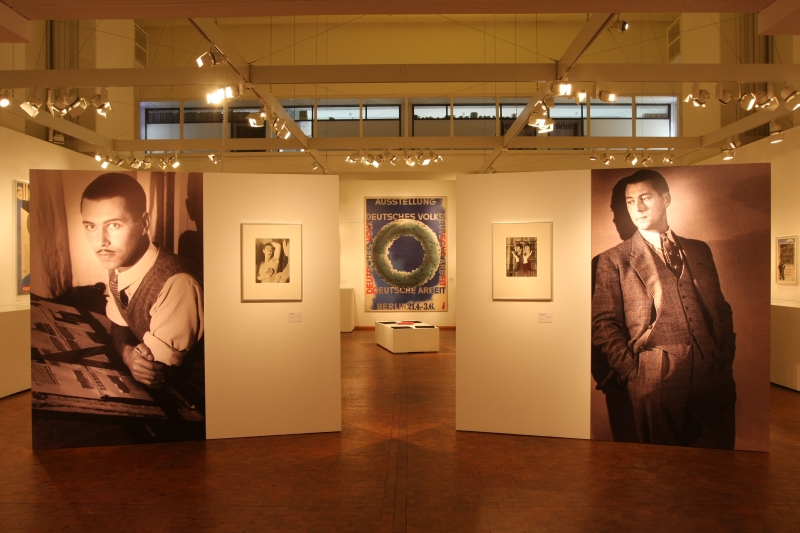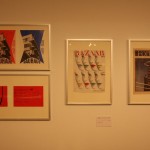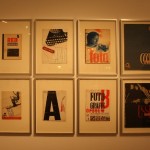Bauhaus Archiv Berlin: Mein Reklame-Fegefeuer. Herbert Bayer. Werbegrafik 1928 – 1938
Until Monday February 24th 2014 the Bauhaus Archive Berlin is presenting the exhibition “Mein Reklame-Fegefeuer. Herbert Bayer. Werbegrafik 1928 – 1938.”
Born in Haag, Upper Austria on April 5th 1900 Herbert Bayer joined Bauhaus Weimar in 1921 and moved with the institution to Dessau in 1925 where Walter Gropius appointed him head of the newly established Print and Advertising Workshop. In 1928 Herbert Bayer departed Bauhaus and established his own commercial graphic design studio in Berlin where he completed commissions for private and public customers, before in 1938 he emigrated to America. In 1964 Herbert Bayer participated in Documenta III in Kassel and in 1968 was responsible for designing the 50th anniversary Bauhaus retrospective in Stuttgart, his last major commission. Herbert Bayer died in Santa Barbara California in September 1985.
Curated by Prof. Dr. Patrick Rössler from Erfurt University, Mein Reklame-Fegefeuer presents examples of Herbert Bayer’s graphic design projects realised between leaving Dessau for Berlin in 1928 and leaving Berlin for America in 1938.
Although ostensibly an exhibition about the graphic design of Herbert Bayer, the exhibition is much more about the political and social developments in Germany during the decade.
A decade that is and was arguably one of the most eventful and globally important in the history of a country that has given the world more “historic episodes” than most.
The first work which one sees is Bayer’s poster for the 1927 Bauhaus Exhibition at the Grassi Museum Leipzig, an event that played an important role in introducing Bauhaus to a wider public. Neatly juxtapositioned to the Leipzig poster stands a series of emergency bank notes Bayer created for the State of Thüringen in 1923. The 50 million Mark note may appear a little exaggerated, but with eggs costing around 320 million Marks each, was still probably a little small.
The innocent hope of Bauhaus and the brutal reality of inflation. This was the period in which Herbert Bayer sought to establish himself.
And establish himself he did.
As in the late 1920s and early 1930s the German economy recovered from the shock of the inflation years, increased financial security saw a period of increased consumerism in Germany, and by extrapolation increased demand for a talented graphic designer such as Herbert Bayer; consequently, in course of the mid-1930s Herbert Bayer advanced to become one of the best earning and highest profile representative of his trade.
A situation which raises the question, how does one become high earning and high profile under a dictatorship?
With his Bauhaus background, Jewish-American wife and modern approach to art and design, the likes of Herbert Bayer should theoretically have had no chance in Nazi Germany. Nor truck with the Nazi regime.
Yet while some of his works were in 1937 entartet – declared Degenerate Art by the Nazis – Herbert Bayer received high profile commissions from public bodies throughout the 1930s.
We ourselves know far too little about Herbert Bayer to come to any form of conclusion, but all sources we trust say that although willingly used by the NSDAP Herbert Bayer was staunchly apolitical and never a member of the party nor a supporter of its manifesto. Something which didn’t stop him completing projects on behalf of the party apparatus, such as the identity/graphic design for the exhibitions “Deutsches Volk, deutsche Arbeit” in 1934 and “Das Wunder des Lebens” in 1935, or a book cover for the Hitler Youth in 1936.
His acceptance by the regime was probably largely due to the NSDAP being clever enough to tolerate him so as to allow them to (mis)use his ability to transport elements of their, at the time still largely unspoken, message. Coupled of course to Herbert Bayer’s ready willingness to let himself be (mis)used. And certainly the regular use of heroic, “Germanic” imagery in many of his mid-1930s works doesn’t appear to be down to random chance alone.
A situation which of course brings us back to the question of how political should designers be. Especially graphic designers, a profession whose talents are largely used to shape emotions, opinions, and by extension decisions. How political should graphic designers be? Mein Reklame-Fegefeuer doesn’t tackle the question directly, but does provide more than enough discussion points to help even the most politically apathetic of visitors reach some form of conclusion.
Hopefully the correct one.
Which is, indubitably, the opposite of the one Herbert Bayer reached.
The exhibition information board comment about the effort Herbert Bayer made to keep his Nazi associations out of later biographies and exhibitions tending to support the view that even Bayer understood his decision wasn’t the cleverest.
By 1938 however even Herbert Bayer was starting to notice that less than positive changes were afoot and decided to leave Germany.
The opportunity came through an offer from Walter Gropius to design the New York Museum of Modern Art’s Bauhaus retrospective, and so fittingly the visitor departs Mein Reklame-Fegefeuer with examples of Bayer’s graphic design for said exhibition displayed alongside further examples of his early American output.
Although we would have liked a little more context, for all in relation to the depth and nature of Herbert Bayer’s contact to and agreements with the NSDAP, Mein Reklame-Fegefeuer provides in the course of the 200 or so exhibits a nice introduction to the man, the period and so the early development of the modern graphic design industry we know today. Through the changes in and evolution of graphic and text styles, layouts and subject matter in the presented works one understands not only how Herbert Bayer developed as an artist, but how much modern graphic designers still owe one of the pioneers.
Mein Reklame-Fegefeuer Herbert Bayer. Werbegrafik 1928 – 1938 runs at the Bauhaus Archiv Berlin until Monday February 24th 2014. Full details can be found at www.bauhaus.de
- Bauhaus Archiv Berlin: Mein Reklame Fegefeuer. Herbert Bayer .Werbegrafik 1928 – 1938
- Bauhaus Archiv Berlin: Mein Reklame Fegefeuer. Herbert Bayer .Werbegrafik 1928 – 1938
- Bauhaus Archiv Berlin: Mein Reklame Fegefeuer. Herbert Bayer .Werbegrafik 1928 – 1938
- Bauhaus Archiv Berlin: Mein Reklame Fegefeuer. Herbert Bayer .Werbegrafik 1928 – 1938
- Bauhaus Archiv Berlin: Mein Reklame Fegefeuer. Herbert Bayer .Werbegrafik 1928 – 1938
- Bauhaus Archiv Berlin: Mein Reklame Fegefeuer. Herbert Bayer .Werbegrafik 1928 – 1938
- Bauhaus Archiv Berlin: Mein Reklame Fegefeuer. Herbert Bayer .Werbegrafik 1928 – 1938
- Bauhaus Archiv Berlin: Mein Reklame Fegefeuer. Herbert Bayer .Werbegrafik 1928 – 1938
- Bauhaus Archiv Berlin: Mein Reklame Fegefeuer. Herbert Bayer .Werbegrafik 1928 – 1938
Tagged with: Bauhaus, Bauhaus Archiv Berlin, Berlin, Herbert Bayer









